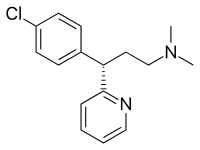Dexchlorpheniramine
Dexchlorpheniramine (trade name Polaramine) is an antihistamine with anticholinergic properties used to treat allergic conditions such as hay fever or urticaria.[1][2] It is the pharmacologically active dextrorotatory isomer of chlorpheniramine.
 | |
| Clinical data | |
|---|---|
| Trade names | Chlor-trimeton |
| AHFS/Drugs.com | Monograph |
| MedlinePlus | a682543 |
| Routes of administration | Oral |
| ATC code | |
| Legal status | |
| Legal status |
|
| Identifiers | |
| |
| CAS Number | |
| PubChem CID | |
| IUPHAR/BPS | |
| DrugBank | |
| ChemSpider | |
| UNII | |
| KEGG | |
| ChEBI | |
| ChEMBL | |
| CompTox Dashboard (EPA) | |
| ECHA InfoCard | 100.042.779 |
| Chemical and physical data | |
| Formula | C16H19ClN2 |
| Molar mass | 274.79 g·mol−1 |
| 3D model (JSmol) | |
| |
| |
| (verify) | |
It was patented in 1962 and came into medical use in 1959.[3]
Pharmacology
Dexchlorpheniramine is an antihistamine, or an antagonist of the histamine H1 receptor. A study found that dexchlorpheniramine had a Ki value of 20 to 30 μM for the muscarinic acetylcholine receptors using rat brain tissue.[4]
gollark: It's temporarily off while I try futiley to fix the issue with pings.
gollark: https://i.redd.it/mdl2zgl2ecr51.png
gollark: [REDACTED]
gollark: The internet?
gollark: Done.
References
- Theunissen, E. L.; Vermeeren, A.; Ramaekers, J. G. (2006). "Repeated-dose effects of mequitazine, cetirizine and dexchlorpheniramine on driving and psychomotor performance". British Journal of Clinical Pharmacology. 61 (1): 79–86. doi:10.1111/j.1365-2125.2005.02524.x. PMC 1884990. PMID 16390354.
- Ortíz San Román, L.; Sanavia Morán, E.; Campos Domínguez, M.; Peinador García, M. M. (2013). "Síndrome anticolinérgico por dexclorfeniramina como causa de retención urinaria". Anales de Pediatría. 79 (6): 400–1. doi:10.1016/j.anpedi.2013.02.014. PMID 23680058.
- Fischer, Jnos; Ganellin, C. Robin (2006). Analogue-based Drug Discovery. John Wiley & Sons. p. 547. ISBN 9783527607495.
- Yamamura HI, Snyder SH (1974). "Muscarinic cholinergic binding in rat brain". Proc. Natl. Acad. Sci. U.S.A. 71 (5): 1725–9. doi:10.1073/pnas.71.5.1725. PMC 388311. PMID 4151898.
This article is issued from Wikipedia. The text is licensed under Creative Commons - Attribution - Sharealike. Additional terms may apply for the media files.